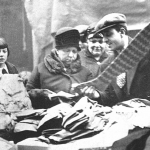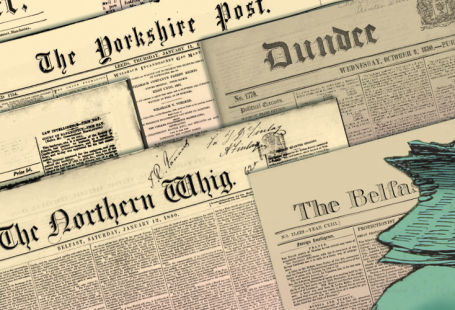The British Newspaper Archive is proud to feature a guest blog by author Naomi Clifford. In 2016, Naomi Clifford wrote The Disappearance of Maria Glenn, a story of crime and coercion about the abduction of a sugar plantation heiress. This year, Clifford is back with a new book, Women and the Gallows 1797-1837: Unfortunate Wretches. Her research into the 131 women hanged in England and Wales involved extensive research in the British Newspaper Archive. Eliza Ross is just one name featured in the new book to be published by Pen & Sword in late November 2017.
On the night of 19 August 1831 84-year-old Caroline Walsh, a street seller of sewing threads, tapes, and laces, was lodging with 33-year-old Eliza Ross and her partner 50-year-old Edward Cook at their garret in Whitechapel in the East End. She was never seen again. Despite the tireless enquiries of her granddaughters at workhouses and hospitals, there was no sign of her.
Finally, the family went to the police, who discovered that within days of Caroline Walsh going missing Eliza Ross had sold Caroline’s clothes and stock of sewing notions to second-hand dealers at Rag Fair in Houndsditch. Eliza and Edward were arrested, along with their 12-year-old son, also called Edward.

This was no ordinary murder, if that was what it was, for no body was ever found. The suspicion was that Eliza Ross and Edward Cook had burked Caroline, that is, she had been killed in order to sell her body to anatomists.
Three years previously, William Hare and William Burke had killed at least 16 people in Edinburgh to sell the bodies to Dr Robert Knox for his dissection lectures. Burke was executed and his name became synonymous with this grisly practice.

Naturally, in the wake of such a sensational case, awareness of burking was high, and the public’s fears were heightened by another appalling case. Less than three weeks before Eliza and Edward senior were committed for trial, the body of a teenage boy was sold to surgeons at King’s College Anatomy School in the Strand, who became suspicious because it appeared never to have been buried. A coroner’s jury found a verdict of wilful murder, and John Bishop and Thomas Williams (aka Head) and other members of their gang were charged with murder. Bishop and Williams confessed to murdering more than 60 others. A crowd of 30,000 watched them die on the gallows outside Newgate on 5 December.
On 5 January 1832, Edward Cook junior gave evidence at the Old Bailey at the trial of his parents for the murder of Caroline Walsh. His account put the weight of blame firmly, and only, on his mother. He said she suffocated Caroline and that his father had looked out of the window and had not seen the murder or taken part in it. Eliza lifted the body off the bed, he said, and carried it downstairs. The following day young Edward found a sack in the cellar with grey hair poking out of the top and later saw his mother carrying the sack across her shoulders through the yard.
Eliza Ross was found guilty and sentenced to death. Edward Cook senior was acquitted.

But was Eliza really a burker? Did Eliza, unassisted, really heft Caroline, who was described as tall and ‘hearty’, over her shoulder in a sack? We cannot know for sure. The Morning Advertiser described Eliza as a ‘large, raw-boned coarse-featured Irishwoman’ who sometimes worked as a porter ‘for which her masculine proportions and strength well qualified her’ but a drawing of Eliza on the dissector’s slab after death does not bear this out. It is troubling that apart from young Edward’s account, there was nothing to show that Caroline Walsh was dead or that Eliza had killed her.
On the day of her execution, a large crowd gathered in the lane outside Newgate. They certainly believed that Eliza was guilty. When she mounted the scaffold a ‘deafening yell and shout’ burst out and when she was ‘turned off’ a cheer went up. Her body was left to dangle for the usual hour after which it was taken to the Royal College of Surgeons for dissection – for, of course, dissection was the standard post-mortem punishment for murderers.

Burking remained a concern to the public, especially the poor, who perceived that they were the most vulnerable to it. Just over a month after Eliza’s execution, a woman described as a ‘street-walker’ was rescued from a cellar in Holborn. A mob, suspecting an attempted burking, ‘gratified their vengeance’ and broke the windows of the house and it was only the intervention of the police that prevented them from demolishing the building.
Eliza’s own body was amongst the last dissected as post-mortem punishment. The Anatomy Bill was given Royal assent in August 1832. The number of corpses of executed murderers was tiny compared to the demand for bodies by the medical profession. The authorities recognized that dissection merely increased sympathy for the hanged (burkers were, perhaps ironically, an exception to this). In future, the bodies of murderers would be buried within the grounds of the gaols where they were executed. The demand for bodies would be met only from the unclaimed dead in hospitals, prisons and workhouses and those donated by relatives in exchange for burial at the expense of the anatomy school.
POSTSCRIPT: Although Eliza Ross’s actual body was obliterated, its form lived on. A report in the Morning Advertiser of 28 September 1832 claimed that ‘full-length’ wax figures of her, Bishop and Williams wearing the clothes they were hanged in, was attracting large crowds to exhibition rooms in High Holborn.

Naomi Clifford blogs about aspects of Georgian life at www.naomiclifford.com and is currently working on her next title, The Murder of Mary Ashford.
Pre-Order Women and the Gallow 1797-1837 now and use this special promotional code – WATG25 – to receive 25% off the RRP and free UK P&P which can be used either on the checkout page of the Pen & Sword website or quoted over the phone on 01226 734222.





